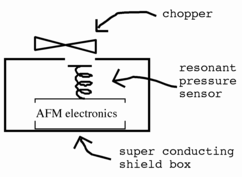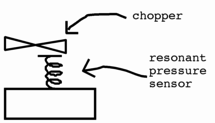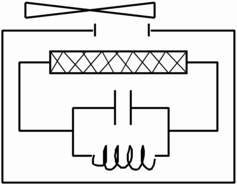During the course of this year's Segre Lecture the speaker, Dr. Masatoshi Koshiba, said something extremely interesting. He said that, according to some deep implications of the Standard Model, that extremely low energy neutrinos, such as those left over from the Big Bang, would reflect from superconductors. He said that, if this is true, that it should be possible to construct telescope mirrors out of superconducting materials and focus the flux of neutrinos onto a detector. However, he then went on to say that, since the interaction cross section for neutrinos is proportional to the square of their energy, detecting the focused beam of neutrinos would be very difficult. Sure, given that multi-MeV neutrinos are almost impossible to detect then it would make sense that milli-eV neutrinos would be a factor of at least a hundred-billion-billion (( "several" *10^9 )^2 ≈ 10^20) times more difficult. In other words: impossible.
Dr. Koshiba then went on to issue a sort of challenge by saying something to the effect that "perhaps some bright, young physics student here will think of a way to detect such low energy neutrinos." OK, I might not be too young or very bright but here goes.
For the sake of argument I'll be assuming that superconductors actually do reflect neutrinos of sufficiently low energy and that the primordial neutrino flux is in fact of a low enough energy to be reflected. If either one of these is not true then nothing here will work.

If the primordial neutrino flux can be reflected from, and focused by, a superconductor then I propose that instead of trying to detect individual low energy neutrinos that we detect them in aggregate. Suppose we point our focused beam of neutrino flux at a superconducting detector and sense the radiation pressure of the flux. We can use a resonant detector -- essentially a mirror on a spring -- and chop the flux at its resonant frequency with a superconducting shutter. See the figure here for a rough sketch.
The temperature of the primordial neutrino background is about half the temperature of the cosmic microwave background -- about 2K. The radiation pressure of electromagnetic radiation at 2K is
Where sigma_B is the Stefan-Boltzmann constant (sigma_B = 5.67*10^-8 W/m^2/K^4), c is the speed of light (c = 3.00*10^8 m/s) and T is the temperature in Kelvin. The flux pressure on a reflecting surface is twice the incident pressure because the reflection is an elastic collision. So the pressure of the primordial neutrino flux on the primary mirror will be
This is a very small pressure to detect with (what amounts to) a moving, mechanical, part. But there are a lot of tricks that can be used to pick it out of the background noise.
More thoughts are required from here but this is looking like its not so impossible after all...

In order to get an idea of whether we can detect the recoil force on the detector we need to make a comparison to other, known, force magnitudes. One possible detection scheme could use an atomic force microscope as the force sensor. Note that this is probably not the best way to detect the actual force but it is a method that I can guess how to estimate. Even without knowing the exact magnitude of the force that an AFM can measure we can make a rough estimation based on materials strength considerations.
In this thought experiment we omit the telescope's primary mirror and try to detect the pressure from the "raw" flux of primordial neutrinos. Our apparatus consists of a superconducting chopper and detector mirror with the detector enclosed in a superconducting shield. There would be an aperture made of ordinary conducting material (copper/mu-metal) to admit the neutrino flux.
The flux recoil force on a 1 cm^2 detector is 6*10^-19 N. This is equal to the breaking strength of a steel wire 3*10^-12 m in diameter which must be about a factor of 10^4 below the maximum force that an AFM could possibly measure without destroying the surface its looking at. If the range of sensitivity (call this parameter the "SNR" of the AFM) of our AFM is better than 10^4, and a 1 cm^2 detector mirror can be used, then we can detect the force using our AFM.
The relevant parameter is the product of:
Again, the use an an AFM is probably not the best way to detect the recoil force from the neutrino flux. Almost certainly there are better methods -- such as using a resonant torsion spring/balance and silicon strain gauge or optical deflection detector rather than an AFM. But since I can make an estimate for the AFM method using materials properties it'll do for now as a demonstration of principle.

An even simpler idea omits the box in the non-imaging detector and is similar to a Casimer type device. The chopper forms one of the plates while the pressure detector forms the other. When the chopper is "closed" there will be a differential pressure on the detector plate -- larger pressure on its back side. When it is "open" the flux pressures will balance in both directions. The difficulty with this arrangement is the close tolerances required between the chopper and the detector.
The chopper must be closer than 1/2 wavelength of the neutrinos or they will "leak" into the space between the plates while the chopper is "closed". Since the chopper is a mirror on both sides, and is immersed in an isotropic flux, it will be illuminated on the side facing the detector unless the detector "shadows" it. And the same goes for the detector -- which means that the parts really do not cast shadows very well (in the geometric optics limit). However, if the two are placed much closer than 1/2 wavelength apart then the neutrinos can't get between the plates.
I think this one, while simpler in conception to the shielded version, is probably technically harder to do because of electromagnetic effects that would probably arise between the two superconducting parts moving in close proximity to each other.

There are probably even better methods of detecting the pressure from the primordial neutrino flux that are not so Rube Goldberg in their (mechanical) construction. One method might be to observe an oscillating current induced in the superconductor by the chopped beam. I imagine that this class of detection schemes would use the equivalent of a tuned "tank" circuit instead of a mechanical mass on a spring.
Again, all this tom foolery assumes that low energy neutrinos do in fact reflect off superconductors -- and that is probably just BS.
I finally contacted Dr. Koshiba and made an enquiry about the neutrino reflection properties he had spoken of. Dr. Koshiba directed me to look up Dr. Paul G. Langacker at the University of Pennsylvania because he was the author of the paper on low energy neutrino detection. Some time later I made contact with Dr. Langacker and he got me pointed to the right paper:
P. Langacker, J. Leveille, and J. Sheiman,
Physical Review D 27, 1288 (1983).
The upshot of all this is that ultra-low energy neutrinos can in fact reflect off of superconductors but the difference in refractive index inside and outside is so slight that only grazing angle reflections would occur. Worse yet, it turns out that the skin depth of the evanescent wave is many meters.
Dang.
From the UC Berkeley Physics Department web site:
Segre Lecture: "The Birth of Neutrino Astrophysics"
The first neutrinos to be observed from an astrophysical source were those from the Sun, and we now have directional, spectral and real-time information on these neutrinos. The birth of the new basic science of neutrino astrophysics was highlighted by the neutrino signal from supernova 1987A in the Large Magellanic Cloud. The talk will conclude with a discussion of the neutrino oscillations of both solar neutrinos and atmospheric neutrinos. All these results were obtained essentially by a single experiment, KamiokaNDE, and they were confirmed by Super-KamiokaNDE.
Speaker is Co-recipient - 2002 Nobel Prize in Physics Masatoshi Koshiba
Affiliation is The University of Tokyo5:45 p.m., George C. Pimentel Hall, University of California at Berkeley
Contact Information is K. Lee 642-3034
This event occurs on 19 Nov 2002